| |
© 1999-2003
Douglas A. Ruby
Revised: 02/06/2003
Aggregate Demand
Aggregate Expenditure
Aggregate Supply
Price Level Determination
Financial Markets and Instruments
The Money Supply Process
Macroeconomic Theory
|
Economic Policy
There is still great debate about the degree to which a government or policy makers should intervene in the affairs of a market economy. At one extreme are those who believe that the market when left alone will generate stable economic growth, rising living standards, low levels of unemployment and inflation, and continue to use resources in the most efficient manner possible. The other extreme is characterized by those who believe in rigorous planning, policy implementation, and in some cases, national ownership of key industries.
This disucssion will take more of a middle road; identifying situations where policy might be desirable or where the lack of policy actions will cause aggregate harm. We will discuss s situations where one type of policy might be desirable as compared to others and situations where certain types of policy is just not practical.
Macroeconomic policy can be divided into two broad categories:
- Demand-side policies designed to affect the ability to spend in an aggregate economy
and
- Supply-side policies designed to affect that economy's ability to produce goods and services.
Further, Demand-side policies can be broken down into:
- Fiscal Policy (changes in Government Spending or Taxes collected)
and
- Monetary Policy (changes to the money supply engineered by the Central Bank)
Expansionary policies will be defined as those designed to stimulate economic growth via
changes in Real GDP (YR), the potential output of the economy (Y*) or both. On the
demand-side these policies would be implemented through one of the four expenditure categories
(Consumption Expenditure, Investment Expenditure, Government Expenditure, or Net Export Expenditure)
that make up GDP. On the supply-side, policies would be designed to add to the productive
capacity of the economy through: labor policies (education, immigration, retirement),
capital accumulation, research and development (seeking technological improvements),
or promoting a greater availability of resources.
For example, a tax cut (a tool of expansionary Fiscal policy) is designed to
increase disposable income thus leading to greater consumption expenditure. In addition, this
tax cut may make certain investment project more profitable thus leading to more investment
expenditure. Changes in government spending are designed to affect the government expenditure
category directly. A fiscal expansion might be designed in this case to offset a decline in one of the other expenditure categories.
Monetary policy is designed to affect investment expenditure through lower interest rates
that accompany increases in the money supply or to effect net export expenditure. In this latter
case, we might observe that a monetary expansion could lead to more dollars being available on
Foreign Exchange markets. This surplus of dollars will weaken the exchange rate between dollars
and other trading currencies. In addition the lower interest rates will make the U.S. a less
attractive place to invest relative to yields that are available in other countries. Thus,
with lower interest rates, there will be an outflow of capital resulting in the sale of
domestic assets and then dollars on Exchange markets. Again, we end up with a weaker dollar.
This weaker dollar makes U.S. exports relatively cheaper to foreign buyers and thus stimulates
the demand for U.S. produced goods. Also, the weaker dollar makes foreign goods more expensive
to domestic buyers reducing the demand for imported goods. The net result is an increase in Net
Export expenditure.
Demand-side policies may be expansionary or contractionary in nature.
Expansionary policies are intended to stimulate spending in a recessionary economy;
contractionary policies intended to reduce spending in an inflationary economy.
However, supply-side policies should always be expansionary--the goal being to increase
the productive capacity of the economy allowing for increases in living standards.
It is important to note that expansionary policies and contractionary policies are not
symmetric in their implementation. Fiscal expansions tend to be politically popular
(i.e., more spending and/or less taxes) and thus easier to legislate. However, in
times of budget deficits, these fiscal expansions make existing deficits worse and add
to the national debt -- debt that at some ratio to GDP may not be sustainable.
Contractionary policies (spending cuts or higher taxes) tend to be politically
unpopular and less likely to be used even if so dictated by economic conditions.
Thus in times of large budget deficits, Fiscal policy tends to be missing from the
policy-maker's tool box.
There is also an asymmetry to the implementation of monetary policy. Monetary expansions
are often less effective and less predictable as compared to monetary contractions.
For example, suppose that the Federal Reserve is concerned about weak economic growth
or relatively high rates of unemployment. The policy reaction would be to increase
bank reserves (excess reserves) through open market purchases. Banks would then be
expected to convert these excess reserves into loans with their customers - an availability
of loans signaled via lower borrowing rates. However, if bankers are somewhat
pessimistic about their future reserve position (expecting higher than usual withdrawal
activity or fewer new deposits), they might just sit on these reserves with no change in
lending rates. Even if bankers want to convert these reserves into loans, potential
customers may not have the incentive to borrow at any rate. A sluggish economy could
be matched with sluggish demand for goods and services thus eliminating the incentive
for investment in inventories or productive capacity. A common saying in this case is
that "you can't push a rope" meaning that it is difficult to push interest rates down
and push borrowing up in efforts to stimulate investment spending.
In contrast, contractionary monetary policy is always effective. Open market operations
that remove reserves from the banking system (an open market sale of securities), will
require that these banks curtail lending activity and allowing competition for fewer
available loans to push interest rates upward. Higher interest rates will always make
certain investment projects unprofitable thus leading to the abandonment of these projects.
In this case we find that the Fed "can pull a rope" - pull reserves out of the banking system
and pull interest rates up will lead to a decline in investment spending.
Fiscal Policy
Our discussion of Fiscal policies will only include expansionary policies.
As stated above, contractionary policies tend to be politically unpalatable and
thus seldom used for economic policy purposes. Expansionary policies, therefore, include increased government
expenditure, lower taxes (tax rates or redefinition of the taxable base) or both. Typically such policies would be
used in cases where the economy is operating well below its potential. In such
cases there are excess resources available for production and thus little pressure
exacted on the price level by these policies.
The use of expansionary fiscal policy was first articulated by John Maynard Keynes in his
General Theory of Employment, Interest, and Money (1936). This work, written in reaction to
the events of the Great Depression, suggested that governments could stimulate effective
demand for goods, where that demand was lacking in the private sector. He stated that
the government could take bank-notes, put them in bottles and bury the bottles around the
country. Individuals would go to some effort to dig up these bottles, acquire the
bank-notes and spend some if not all of this newly-discovered purchasing power.
To be more practical in his suggestion, Keynes, stated that governments could in a
similar fashion, stimulate demand by spending
(Δ[+]G) on necessary public projects
(administrative buildings, roads, dams, and other infrastructure) thus putting
the unemployed to work in gainful industry. These workers earning a legitimate
income would then begin to spend on goods and services - spending that would lead
to inventory depletions and thus create additional employment in the production and
replenishment of these inventories. Through this multiplier process 'α', demand and thus
Real GDP would increase closer to the potential of the economy as defined by Y1 in the diagram below:
Δ[+]G = Δ[+]Ao
--> Δ[+]YR = αΔ[+]
Ao
Figure 1, An Increase in Government Spending
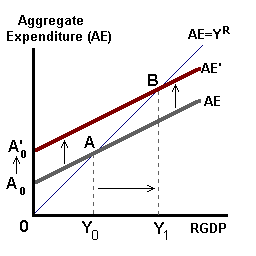
A reduction in taxes will have a similar effect on RGDP except, in this case, the
change will occur through changes in consumption expenditure. Lower tax rates increase
the value of the spending multiplier 'α'. Given that this multiplier is defined as: α = 1 / [1 - mpc(1 - t)]:
t  ,
(1 - t) ,
(1 - t) , therefore mpc(1 - t) , therefore mpc(1 - t)  , the expenditure line becomes steeper, , the expenditure line becomes steeper,
and
[1 - mpc(1 - t)] ,==> α ,==> α  . .
Figure 2, A Reduction in the Tax Rate
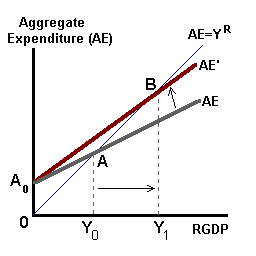 The Crowding Out Effect
The Crowding Out Effect
If we focus on the real economy (Real GDP and corresponding expenditure categories)
we might conclude that expansionary fiscal policy will be effective in increasing Real GDP.
However, by taking into consideration the feedback role of financial markets, this may not
always be the case.
We know that the demand for money (cash balances) is affected by changes in
aggregate income -- the transactions demand for money. Expansionary fiscal policy
will lead to increases in aggregate income as shown by the movement from points 'A'
to 'B' in the diagram below-right. However these changes in income will also shift
the demand for money 'Md' outwards -- more
money being desired to facilitate increased spending. Holding the money supply
'MS' constant will result in an
excess demand for cash balances. Individuals will make portfolio adjustments
(selling financial assets in exchange for cash) pushing asset prices down and asset yields
(and interest rates) up. In place of portfolio adjustments, individuals may also attempt
to borrow more from financial intermediaries (banks) but be unable to do so given the
unchanging reserve position of the banking system. Interest rates will be pushed upwards
given this excess demand. Higher interest rates will lead to higher borrowing costs
resulting in some planned investment projects being abandoned (projects that are no
longer profitable at these higher borrowing rates). As investment expenditure declines,
aggregate expenditure 'AE' also declines as shown by the movement from points
'B' to 'C' in the diagram below-right. In summary, because of activity
in financial markets, the fiscal expansion has crowded-out private investment
spending. This crowding out may be partial as shown below or could result in a dollar
for dollar replacement of private spending by public spending.
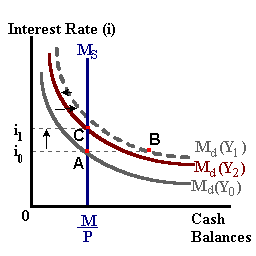 |
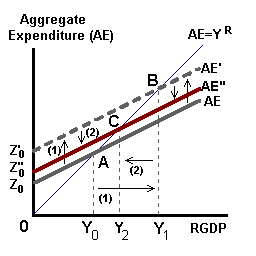 |
Monetary Policy
Expansionary Monetary policy may be used for the same reasons as expansionary fiscal policy -
weak aggregate demand and an economy operating below its potential. The Federal Reserve
will only be comfortable using this type of policy if there is little chance that inflation
will not become a future problem because of these policies (i.e., π = 0 thus, 'i' --
the nominal rate of interest = 'r' -- the real rate).
In this instance, the Fed will use open market operations to purchase Government
securities from Treasury dealers paying for those securities with newly created reserves.
In the purchase of these securities, the Federal Reserve N.Y. trading desk will put upward
pressure on these bond prices thus driving their yield downward
(Ψ  ).
The reserves finding their way into the banking system as excess reserves will be converted
by bankers into new loans - loans available to borrowing customers at lower interest rates.
In the diagram below left this increase in reserves is shown as an outward shift in the money
supply line. As interest rates fall, the opportunity cost of holding cash balances also falls.
The public will be willing to hold larger cash balances in the form of new deposits. In the
diagram on the right we find that as interest rates fall, borrowing intended for investment
expenditure increases thus shifting the AE line upwards. This is similar to an autonomous
shock (note: in the diagram below-right, Z = Ao - h(r)) such that the increase
in investment spending, working through the spending multipler will lead to an increase in income closer to the
potential of the economy at Y1: ).
The reserves finding their way into the banking system as excess reserves will be converted
by bankers into new loans - loans available to borrowing customers at lower interest rates.
In the diagram below left this increase in reserves is shown as an outward shift in the money
supply line. As interest rates fall, the opportunity cost of holding cash balances also falls.
The public will be willing to hold larger cash balances in the form of new deposits. In the
diagram on the right we find that as interest rates fall, borrowing intended for investment
expenditure increases thus shifting the AE line upwards. This is similar to an autonomous
shock (note: in the diagram below-right, Z = Ao - h(r)) such that the increase
in investment spending, working through the spending multipler will lead to an increase in income closer to the
potential of the economy at Y1:
Reserves  , ==> Excess Supply of Money,
==> i , ==> Excess Supply of Money,
==> i , Md , Md  , ,
as
i  ; r ; r  ,
[Ao - h(r)] ,
[Ao - h(r)]  ==>
I ==>
I , and Δ[+]Y =
α[Ao - h(Δ[-]r)]. , and Δ[+]Y =
α[Ao - h(Δ[-]r)].
Figure 3, Expansionary Monetary Policy
In the case of contractionary monetary policy, the Federal Reserve is reacting to inflationary pressure in the economy due to an increase in aggregate demand (more purchasing power) or a reduction in potential output perhaps due to an adverse productivity shock or an increase in factor prices. In both cases, the economy's ability to spend exceeds its ability to produce leading to upward pressure on output prices.
Figure 4, An Increase in Aggregate Demand
(putting upward pressure on the Price Level)
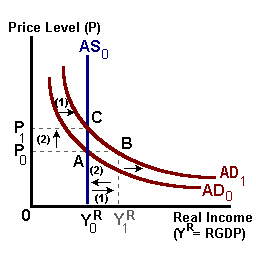
The Fed will combat this increase in demand-side spending by
pushing interest rates upward and increasing the costs of borrowing
to weaken investment spending and shift aggregate demand back near
AD0.
This contractionary monetary policy would therefore require
changes opposite to those described above:
Reserves  , ==> Excess Demand for Money,
==> i , ==> Excess Demand for Money,
==> i  , Md , Md  , ,
as
i  ; r ; r ,
[Ao - h(r)] ,
[Ao - h(r)]  ==>
I ==>
I , and Δ[-]Y = α[Ao - h(Δ[+]r)]. , and Δ[-]Y = α[Ao - h(Δ[+]r)].
The open market sale of government securities would create a surplus of these securities in secondary bond markets thus driving their price down and yields up
(Ψ  ). ).
In reality the directive to the N.Y. trading desk from the Federal Open Market Committee
will be to buy and sell securities until a particular interest rate (Federal Funds) target has been met. Because of day to day changes in the money multiplier, withdrawal and deposit activity, and other forces; the actual Federal Funds rate will hover around this target. However, if the goal of the Fed is to increase this short-term rate, other interest rates (i.e., the Prime Lending Rate) are likely to follow with the consequent effect on Investment expenditure decisions and ultimately Real GDP.
SUPPLY-SIDE POLICIES
Supply-side are designed to work through the aggregate production function by affecting the availability of factor inputs or their productivity:
X* = f(L, K, M).
These policies can be categorized via each of the three factors of production listed in the above function.
Labor Policies
Policy makers have attempted to increase the potential output of an economy via the labor-input component. These policies represent an attempt to increase labor supply via relaxed immigration policies, population (encouraging greater birth rates) policies, or increasing labor force participation rates. Policies can also attempt to increase the productivity of labor (an increase in Human Capital) through improved access to education and policies designed to make educational activities more effective.
Capital Accumulation
The capital stock of a nation, so important for rising living standards, can also be affected by different policies. Governments are often involved in the direct creation of necessary infrastructure that complements and enhances the movement of goods and services as well as reducing the transaction costs associated with market activities. This infrastructure may include new roads (i.e., the U.S. Interstate system), bridges and dams, airports, and improvements to waterway shipping. In addition this infrastructure may include legal systems, courts and police to help make market transactions more efficient.
Policy makers can also encourage capital accumulation through the private sector through grants and subsidies for research, development, and capital creation. Tax laws can also favor capital by lowering the real cost of borrowing thus encouraging investment spending -- spending on new capital and the replacement of existing capital.
Availability of Raw Materials
Policies may also be developed to improve access to and the general availability of raw materials. These types of policies would include different land-use/land-management policies allowing for resource extraction, logging, oil exploration, and urbanization. Often these types of policies run counter to efforts at environmental protection leading to strong debate in the political arena.
Concepts for Review:
- Fiscal Policy
- Monetary Policy
- Expansionary Policy
- Contractionary Policy
- Supply-Side Policies
- Recession
- Inflationary Pressure

|